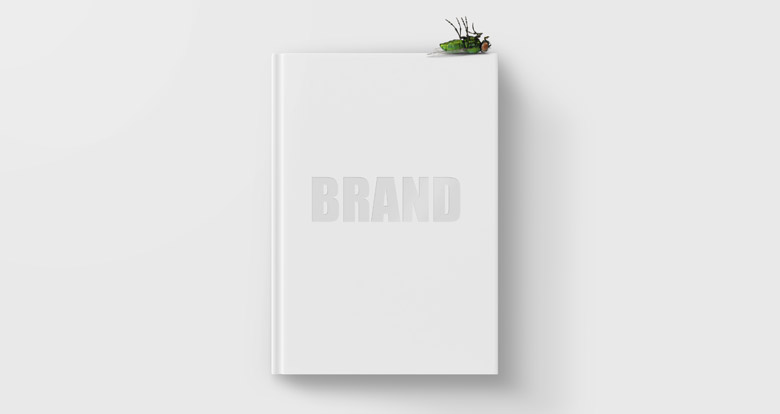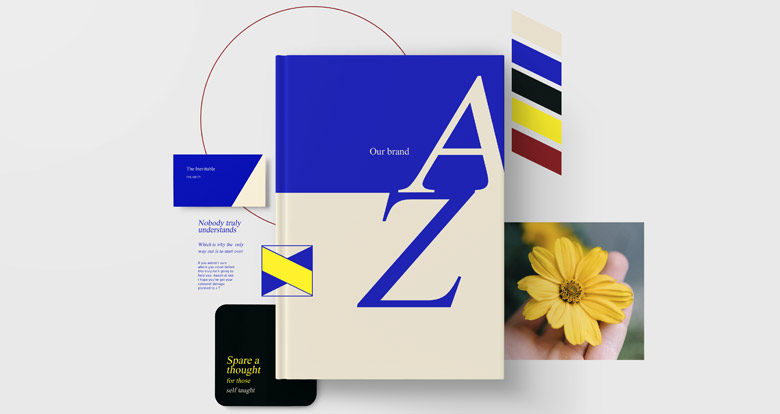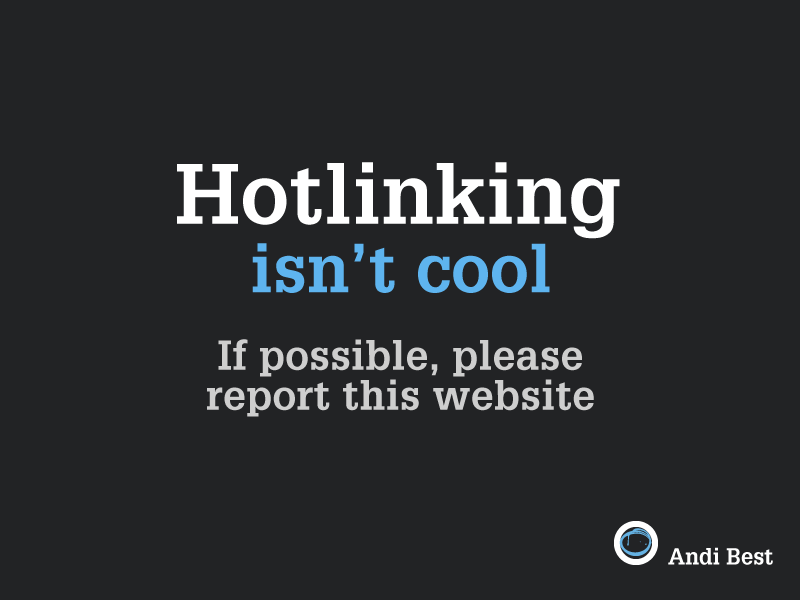Your Brand Guidelines Possibly Suck and Someone Needs to Tell You
- Published 12-02-2023
- Share

You absolutely love chucking your brand guidelines around, don't you? You'll stick those things to emails like shoes on a cinema floor.
And why not? You paid good money for them. They look incredibly slick and they auto-brief external designers like me on how to use your brand in the work we create for you. Or at least, they're supposed to. Here's a question - have you actually read them?
Because I have. I have to. You sent them to me and it's important for my job that I familiarise myself with them.
I have read the brand guidelines of countless businesses over the years and what I've found alarming is that very few have been entirely compelling or even relevant.
What follows is a jaunt through some of the eyebrow-raising discoveries I've made clicking through various guideline files, which may prompt you to have another gander at your own.
And why not? You paid good money for them. They look incredibly slick and they auto-brief external designers like me on how to use your brand in the work we create for you. Or at least, they're supposed to. Here's a question - have you actually read them?
Because I have. I have to. You sent them to me and it's important for my job that I familiarise myself with them.
I have read the brand guidelines of countless businesses over the years and what I've found alarming is that very few have been entirely compelling or even relevant.
What follows is a jaunt through some of the eyebrow-raising discoveries I've made clicking through various guideline files, which may prompt you to have another gander at your own.
No lorem ipsum please
No matter how luxuriant and cerebral your brand may be, unless your target audience is exclusively centred in 7th century Italy, there really is no credible allowance for Lorem Ipsum in your design guidelines.
Nothing says 'your design agency got bored putting your brand together' quite like whole chapters of its guidelines forsaken in favour of Latin placeholder text, especially beneath predefined headings like 'Tone of Voice' or 'Our Values'. That your brand was borne from a stock template is testament in itself to how unexceptional it is.
I'm not sure how something like this gets past compliance, so just, please, just, read the damn things before signing them off. This is oddly common.
Nothing says 'your design agency got bored putting your brand together' quite like whole chapters of its guidelines forsaken in favour of Latin placeholder text, especially beneath predefined headings like 'Tone of Voice' or 'Our Values'. That your brand was borne from a stock template is testament in itself to how unexceptional it is.
I'm not sure how something like this gets past compliance, so just, please, just, read the damn things before signing them off. This is oddly common.
Logo nopes
I love the logo nopes. Their absurdity never fails to delight. They're a staple of every guidelines I've ever seen and they are wholly unnecessary. Whilst the rest of the document serves to instruct best practice to support the brand, this chapter relishes in how awful things could become. It always presumes the reader is of questionable judgement and in need of very specific hand-holding.
'How Not To Use Our Logo' or similar will head the page, followed by a hilarious sequence of mock-ups depicting the company logo in a variety of ways that no component designer would ever feasibly recreate.
"Please do not alter the colourisation of our logo to an arbitrary, putrid palette." Understood.
"Please do not partially rotate, skew, and then crop the left edge of our logo for no discernible reason." Got it, I obviously would never do that.
"Please do not change the style, lettering, design, or underlying conceptualisation of our logo in any way." So, don't ruin the logo - that's a given.
What baffles me is how limited this list is; why the author felt this particular handful of violations warranted legislation but not the infinite other methods of destroying the logo's integrity. "Please do not reinterpret our logo as from the perspective of a distant naval vessel" or "When spraypainting our logo onto the hides of live animals please consult our approved species list" are never covered, for example.
'How Not To Use Our Logo' or similar will head the page, followed by a hilarious sequence of mock-ups depicting the company logo in a variety of ways that no component designer would ever feasibly recreate.
"Please do not alter the colourisation of our logo to an arbitrary, putrid palette." Understood.
"Please do not partially rotate, skew, and then crop the left edge of our logo for no discernible reason." Got it, I obviously would never do that.
"Please do not change the style, lettering, design, or underlying conceptualisation of our logo in any way." So, don't ruin the logo - that's a given.
What baffles me is how limited this list is; why the author felt this particular handful of violations warranted legislation but not the infinite other methods of destroying the logo's integrity. "Please do not reinterpret our logo as from the perspective of a distant naval vessel" or "When spraypainting our logo onto the hides of live animals please consult our approved species list" are never covered, for example.
Get to the point (sizing)
"Our heading typeface is X and our body typeface is Y". Fantastic, but, erm, where's the rest? The objective here is consistency, so, in the past how have you managed point sizing? Leading? Weight? Margins? There is (should be) so much more to the visual fundamentals of your brand that text configurations like these shouldn't be left open to interpretation. It's not militant to define how much spacing should be between lines of text at various scales, for example; it's helpful. So long as examples are ample and annotation is clear you can get quite technical here and it not become oppressive.
Don't be shady
A breakdown of colour definitions by numerical references and digital codes is a staple of all brand guidelines, but please ensure those variants and values are complete and properly formatted for ease. Don't include the decimal points in your hexadecimal codes, for example. They'll only need manually removing when porting to design software. Don't make mention of your Pantone spot colour codes and then not include them in your conversion chart, for another example.
Also if tints of your brand colours are permitted, please define what the allowed opacity levels should be.
As colourful as your brand may be, these omissions can leave your designer in the dark.
Also if tints of your brand colours are permitted, please define what the allowed opacity levels should be.
As colourful as your brand may be, these omissions can leave your designer in the dark.
Wooly stuff is ok - the agency needs a brain dump and cost justification - but there's a limit
I once worked on a web design project for mobile network Orange and the opening gambit of their design guidelines sought to impress upon me the embodiment of a pervasive glass door running through all visual communications. Whilst that's lovely, pretentious poetry, it didn't really tell me anything. It is broadly open to (mis)interpretation. My experience and creative intuition understood this to be a request for a light and airy aesthetic, conveyed through a spectrum of subtle white and grey tones denoting glossy reflections. But I could just as easily have designed the site to look smeary, watermarked and with a collection of expired insects festering at the bottom.
I'm happy to read about your values, your origins, and anything else that may set the appropriate tone of your business, but can we agree to curb the pitch-winning flowery nonsense like "all customer interaction should snap with the crispness of a shattered beetle thorax underfoot"?
I'm happy to read about your values, your origins, and anything else that may set the appropriate tone of your business, but can we agree to curb the pitch-winning flowery nonsense like "all customer interaction should snap with the crispness of a shattered beetle thorax underfoot"?
72 pages
72 pages!? Are you kidding me? Your exceptionally minimalist, negative-space championing brand aesthetic has somehow garnered 72 pages worth of instruction?
I know my gripes above have principally concerned information omission but brevity is also a powerful tool.
I promise you, unless a designer embarks on an intimate, multi-year contract entangling with your brand system each and every day, they aren't going to digest your short novel.
Contents > Type > subheadings: size 18pt > *close document*; that's representative of a typical interaction a designer will need with your guidelines. They certainly won't be interested in wading through countless screenshots of intricate Photoshop panel configurations and other artificial hurdles. If your brand requires volumes to adequately define it, there's a high chance it's overcomplicated and unworkable.
I know my gripes above have principally concerned information omission but brevity is also a powerful tool.
I promise you, unless a designer embarks on an intimate, multi-year contract entangling with your brand system each and every day, they aren't going to digest your short novel.
Contents > Type > subheadings: size 18pt > *close document*; that's representative of a typical interaction a designer will need with your guidelines. They certainly won't be interested in wading through countless screenshots of intricate Photoshop panel configurations and other artificial hurdles. If your brand requires volumes to adequately define it, there's a high chance it's overcomplicated and unworkable.
Collateral ain't coaching
Lovely flyer for your 2018 summer sales event you've included towards the back of your brand guidelines. Great little page filler from the agency pitch deck. I'm sure on the next slide there's a full breakdown of why that's there and how it was constructed and which parts are relevant to me now and— oh look, the 2019 summer sales event leaflet...
Existing collateral (stationery, posters webpage screenshots, etc.) lumped into your brand guidelines aren't... well... guidelines. They're examples of things you've had designed presumably using some form of guidelines. It's those instructions I want to see; the guidelines that steered those pieces of work. Seeing how your brand exists in the wild is useful but without accompanying annotation, these creatives boil down to little more than pretty pictures. I can ape what I see, but I can't deduce rationale or replicate with precision. Tell me why the photography choices were made, why the blocked colour sections are positioned as they are, why the headings wrap after so many characters etc. Show your working, as my maths teachers used to say.
Don't brief illegally
Finally, please do educate yourself on the content of your brand guidelines and understand the principles behind what's written there. Familiarise yourself with the fundamentals. If your brand guidelines prohibit certain colours or stipulate fixed element sizing (as they should), please internally consider those rules before briefing design jobs that contradict them.
How firmly the "guidelines" imprint on a project is ultimately a collaborative decision between the client and myself. They aren't "design laws". But your design agency has done the functional maths, calculated the proportions and balance and arrived at a rule set that actually works. Things will fit. The end results will look great. Straying arbitrarily from the conventions outlined will only lead to rounds of amends after amends after amends.

So what makes for good brand guidelines?
Lest this piece offer no educational value or useful conclusion, I'm going to wrap up with a few exemplary aspects of brand guideline content I've encountered so far in my career:
Logo framing
We've covered "logo don'ts", but how about "logo must ensures". Great guidelines will stipulate things like perimeter clear space, or ideal sizing, or even design variants per scale.
Decent sizing and placement of a logo in a layout should be intuitive to a skilled designer, but inconsistency of precisely how that's achieved across documents can easily creep in if left unchecked.
I've seen logo dimensions regulated by guidelines, as well as a prop for defining the clear or "breathing" space around a logo using an element extracted from the design (such as the device or a single letter) bordered around it. It's an unusual but creative solution that alleviates a designer needing to mismeasure with his own ruler.
Decent sizing and placement of a logo in a layout should be intuitive to a skilled designer, but inconsistency of precisely how that's achieved across documents can easily creep in if left unchecked.
I've seen logo dimensions regulated by guidelines, as well as a prop for defining the clear or "breathing" space around a logo using an element extracted from the design (such as the device or a single letter) bordered around it. It's an unusual but creative solution that alleviates a designer needing to mismeasure with his own ruler.
Top to bottom
A complete, fully annotated breakdown of content hierarchy is a wonderful thing to find in brand guidelines. The idea is to present mocked-up documents (OK, so here you can use some Loren Ipsum) exhibiting how to correctly style headings, intro copy, quotes, subheadings etc. Not merely a descriptive suggestion of how these things could look, but a definitive structured example from top to bottom of how they all work together in a layout. A designer can tune into the balance and rhythm of that, follow the accompanying instructions, and replicate it reliably in future work.
Photography rationale
Instead of a choice selection of photography the brand may have adopted or commissioned once upon a time, great guidelines will try and articulate the creative brief behind these shoots. They'll offer a comprehensive account of the rationale behind the imagery; what lighting choices were made, what the subjects and focus points were, why the props and settings were significant, what atmosphere, mood, language and message the final images aimed to convey.
Photography is a critical vehicle for telling your brand story, so just as the hexadecimal values of your palette are pinpointed, so too should be the breakdowns of visual ingredients that make up your photography.
Photography is a critical vehicle for telling your brand story, so just as the hexadecimal values of your palette are pinpointed, so too should be the breakdowns of visual ingredients that make up your photography.
Icons
Similar to photography, iconography and symbol graphics need to be more than a contextless page-filler. I've seen guidelines with great definitions of illustrative style through written instruction; guidance on how each flow arrow, each content box and each curved embellishment should function within a layout to direct the eye around a piece.
To use an analogy: a shopping list for ingredients is handy but the accompanying recipe to actually produce something meaningful with them is paramount.
To use an analogy: a shopping list for ingredients is handy but the accompanying recipe to actually produce something meaningful with them is paramount.
Query touch point
Guess what? If you've thrown a 72 page document (72 pages!? Are you kidding me?) at a designer that you feel resolves every granule of your brand system, I've got news for you. There will still be questions. Some aspect won't be explained thoroughly or clearly, some custom sizing format will have been omitted or overlooked, or something in a brief will contradict those sacrosanct pages.
Before artistic license takes the wheel in these situations, some exemplary guidelines I've seen sign off with a page dedicated to the point of contact. The brand manager's email address, the design studio's hotline, whoever. Channels towards the appropriate body with whom a constructive dialogue can form about what's best for the brand when the guidelines don't have the answer.
Before artistic license takes the wheel in these situations, some exemplary guidelines I've seen sign off with a page dedicated to the point of contact. The brand manager's email address, the design studio's hotline, whoever. Channels towards the appropriate body with whom a constructive dialogue can form about what's best for the brand when the guidelines don't have the answer.
After reading this, blow the dust off your brand guidelines and ask yourself three questions:
Are they complete? If there are plot-holes in thoroughness, uncovered topics, or entire sections written in an archaic language, you should consider getting these areas cogent, perhaps with the help of a designer in your own organisation.
Do you understand them? Perhaps not all the technical jargon needs to make sense to you but it's best to have a basic understanding of the areas covered to ensure you and the designer develop a symbiosis with the brand, sharing the same interpretations of its minutiae.
Are designs coming back way off track? If you're repeatedly seeing design work returned that's far from airtight it could be that the designer is getting lost in the puff, or confronted by polysemic directives. Ensure there's always a defined objective enforcing each rule so the designer can follow the why as well as the how. And if all else fails, give your designer an appropriate avenue to direct their questions.
Want to read blog updates as they're published? Sign up to my newsletter for blog update alerts. Join my newsletter

 T-shirt challenge
T-shirt challenge